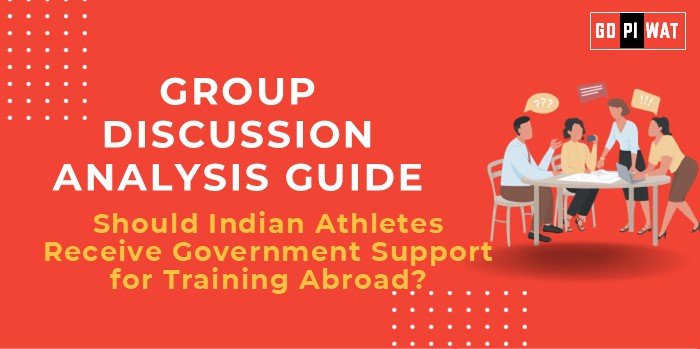📋 Group Discussion (GD) Analysis Guide
🏅 Should Indian Athletes Receive Government Support for Training Abroad?
🌐 Introduction to the Topic
Sports play a pivotal role in fostering national pride and international recognition. India’s growing ambitions in global sports necessitate a robust support system for athletes.
Background: Historically, Indian athletes have faced challenges like lack of infrastructure and training resources. Training abroad offers exposure to advanced techniques and facilities, but it requires significant funding, often unaffordable for many athletes.
📊 Quick Facts and Key Statistics
- 🏅 Global Sports Ranking: India ranked 33rd in the Tokyo Olympics (2021), with 7 medals.
- 💰 Government Funding: Sports Budget was ₹3,062.60 crore in FY 2023-24.
- ✈️ Training Abroad: Nearly 120 Indian athletes trained abroad under the TOPS in 2023.
- 📈 Cost Factor: Overseas training costs range from ₹20 lakh to ₹1 crore per athlete annually.
🤝 Stakeholders and Their Roles
- Government Bodies: Ministry of Youth Affairs and Sports funds programs like TOPS.
- Sports Federations: Facilitate athlete selection and training arrangements.
- Athletes: Represent the country; require resources for enhanced performance.
- Private Sponsors: Bridge funding gaps through sponsorships and endorsements.
- Public: Drive demand for greater investment in sports through support and viewership.
🏆 Achievements and Challenges
✅ Achievements
- 🥇 Increased Medals: India’s best Olympic medal tally (7) in 2021 attributed partly to foreign training.
- 🌍 Global Recognition: Athletes like Neeraj Chopra have benefited from international coaching.
- 📜 Policy Initiatives: Programs like Khelo India and TOPS prioritize athlete development.
⚠️ Challenges
- 💸 Funding Constraints: Limited budget for all sports disciplines.
- ⚖️ Inequity: Disparities between high-profile and lesser-known sports.
- 🌎 Global Comparisons: Countries like China and the USA invest significantly more in athlete training.
💡 Case Study
🏅 Neeraj Chopra: Trained in Germany under TOPS and won Olympic gold in 2021, showcasing the benefits of targeted overseas training.
📚 Structured Arguments for Discussion
- Supporting Stance: “Government funding for overseas training is critical to bridge the gap in resources and ensure global competitiveness.”
- Opposing Stance: “Domestic infrastructure should be prioritized over expensive foreign training to develop long-term capacity.”
- Balanced Perspective: “While training abroad is essential for elite athletes, parallel investments in domestic facilities are necessary for sustained development.”
🔍 Effective Discussion Approaches
- Opening Approaches:
- Highlight India’s Olympic success in 2021 as a result of international exposure.
- Ask whether India should prioritize short-term results or long-term capacity-building.
- Counter-Argument Handling:
- Acknowledge high costs but argue the returns in global recognition justify the investment.
- Promote balance by proposing investments in both foreign training and domestic infrastructure.
📈 Strategic Analysis of Strengths and Weaknesses
- 🟢 Strengths: Proven success stories, robust government initiatives like TOPS.
- 🔴 Weaknesses: High costs, uneven access across sports.
- 🟠 Opportunities: Public-private partnerships, leveraging foreign expertise for domestic training.
- ⚫ Threats: Over-reliance on foreign training, neglect of local infrastructure.
🎯 Connecting with B-School Applications
- Real-World Applications: Resource allocation strategies, sponsorship models in sports management.
- Sample Interview Questions:
- What are the trade-offs between foreign training and domestic investment?
- How can public-private partnerships boost India’s sports ecosystem?
- Insights for B-School Students: Opportunities in sports sponsorship, policy analysis, and resource management.


